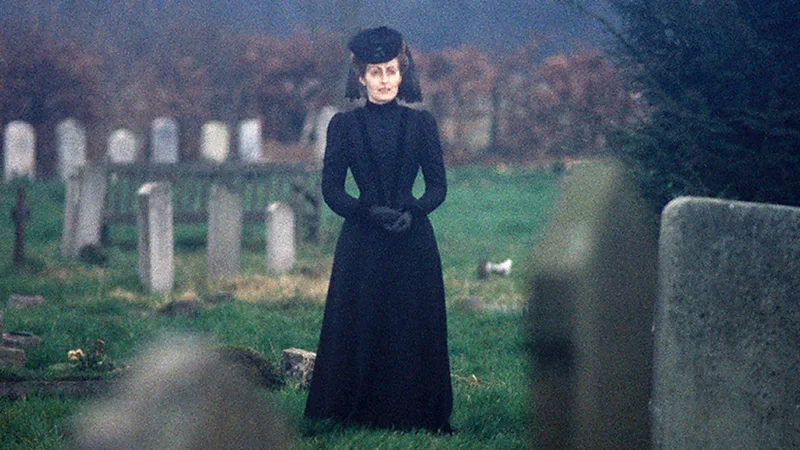The ultimate Christmas ghost story: How 1980s horror The Woman in the Black terrified Britain
First airing on Christmas Eve 1989, the original TV adaptation of Susan Hill's creepy novel The Woman in Black contains what some consider one of the greatest scares in screen history.

In the history of British television, there's arguably never been a scene so petrifying. Airing on Christmas Eve on ITV back in 1989, director Herbert Wise's adaptation of Susan Hill's novel The Woman in Black represented the pinnacle of the British tradition of festive ghost stories. But while the drama as a whole provided a uniquely slow-burning dread, one moment in particular has earned its place among the great horror sequences of all time – and surely ruined a lot of people's Christmas sleep in the process.
An earnest Victorian lawyer called Arthur Kidd (played with real heart and lip-quivering fear by British actor Adrian Rawlins) has been stalked by ghosts around a creaky waterside mansion called Marsh House. Having been chosen by his law firm to sort out the will and estate of a recently deceased client called Mrs Drablow, Kidd is instead confronted with the undead souls of this client's tragic sister Jennet Goss (played by Pauline Moran) – the titular Woman in Black – and her mischievous son Nathaniel (a giggling child apparition who throws balls at people). Having somehow escaped Marsh House without succumbing to a heart attack, Kidd finds sanctuary in a bed at the local pub, lulling the viewer into a false sense of security. You genuinely believe his torment is, finally, over.
But suddenly a feral noise, which sits somewhere between a mating fox and a grieving mother wailing into the abyss, chills out the air. The snarling Woman in Black then emerges from behind a curtain, floating in slow motion towards a crying Kidd, who is clutching on to his sweaty bed sheets for dear life. "I remember watching it with my friend Leslie, and we screamed so loudly," recalls a laughing Mark Gatiss, the esteemed Sherlock actor, screenwriter and horror connoisseur. He is a high-profile fan of the 1989 The Woman in Black, even doing an audio commentary for a long-awaited 2020 DVD re-release. Gatiss believes this moment is among the greatest jump scares in screen history, primarily because it terrifies you, even if you know it's coming, as with similarly well-constructed scenes in the likes of Jaws or Psycho.
"I can still hear [Leslie and me] both bellowing in terror right now," Gatiss adds. "The scene just puts this chill throughout your whole body. Pauline Moran's stare is pure malevolence! I think for the whole nation, the advert break – which came directly after the jump scene – was a complete relief; a lot like finding water when lost in the desert. Once you saw it, nothing was the same again, and the next day you were still thinking about it while your dad was carving up the Christmas turkey."
All credit must go to Moran, not just for the stare but the unholy sound too. "It wasn't special effects, it was all me!" she tells the BBC. "I made it from the very roof of my mouth, and I wanted to create a banshee-like sound or something akin to a circular saw chiselling away. I remember there was a wind machine, and I was standing on the dolly going forward as the camera moved backwards, which all creates this unnerving movement for the viewer."
"In general, I wanted Jennet's movement to feel like she wasn't just stumbling forward but floating above the ground like a witch," she continues. "In this one moment you had to feel all her fury and it needed to be like Mother Nature taking out her vengeance, so I gritted my teeth and focused my stare on Adrian [Rawlins] until I pretty much gave myself a headache. They cast me in the role because I was paler than the pre-Raphaelites and already very ghost-like in complexion. Anyway, I remember Adrian screamed so loudly he lost his voice, so I must have done my job well, right?"
Its cult reputation
Do her job well, Moran certainly did. In the 35 years since its release, the 1989 TV adaptation of The Woman In Black has developed a cult following (other major fans include Guillermo Del Toro) and Moran's ghostly matriarch, who only appears five times and never utters a single word, clearly haunted viewers long after the credits rolled. Writing about the TV film at the time, the Guardian's Nancy Banks-Smith noted: "It creates a genuine physical reaction as if one layer of your skin has shifted over another."
A big driver behind the film's subsequent intrigue and cult status was its obscurity. Due to a battle over the licensing rights, Wise's Woman in Black was out of print for many years and difficult to track down, which added to the word-of-mouth buzz around its spookiness. Although today it's finally in reach – and you can stream it right now on Amazon Prime in both the US and UK – for decades previously you could only really experience the TV film if you were in the UK and already knew someone with a beaten-up home recording or a limited-run VHS tape released in high-street retailer WHSmith. "In the years after it aired, maybe horror became this thing where people just chopped each other into bits," theorises Moran. "But our film has such a slow-burn power. I guess as horror became more and more gimmicky, that sort of lurking menace in our production shined more and more brightly, and people became ever so passionate about tracking it down."
The Woman in Black is a gothic tale pretty much embedded in the British national psyche – Hill's book is regularly studied in schools and it has also spawned a stage version, which played at London's Fortune Theatre for 34 years until March 2023, making it one of the West End's longest ever running plays.
The story centres on its determined lawyer hero (called Arthur Kidd, rather than Kipps, as in the original book) trying to make sense of the haunted house he finds himself assigned to sort out, and also the fact that children in the local town of Crythin Gifford keep dying in mysterious circumstances. He works out that in life Jennet Goss, aka the Woman in Black, had been barred by her sister from seeing little Nathaniel, who was born out of wedlock and adopted by Mrs Drablow's family due to the cultural taboos of the time. Jennet protested in the town about her treatment to whoever would listen, but the locals treated her like she was invisible and already a ghost.
As he discovers, after Jennet finally kidnapped Nathaniel back, the mother and son tragically died while trying to escape on the foggy Nine Lives causeway, which separates Marsh House from the mainland. Their horse and carriage are sunk in the marshes, with their desperate screams then etched permanently into the surrounding environment. In death Jennet subsequently transforms into The Woman In Black, who has a seething eternal rage and supernatural purpose to go after all those who've had the luxury of nurturing children.
In 2012, it was also adapted into a film starring Daniel Radcliffe by the revitalised Hammer Horror film studio, but this was largely a forgettable experience, relying too much on unbelievable CGI and stereotypically creepy child actors. In this version, the Woman In Black looks less like a person and more like a clichéd, digitised Hollywood hag, and everything that follows therefore lacks nuance.
What makes it so unique
For lead actor Rawlins, the reason the 1989 TV version remains the best adaptation of Hill's celebrated novel is primarily due to its innate Britishness. "It was like stepping back into the Victorian era, and Herbert Wise really captured the drabness of those times," he says, "which makes the world feel so much more alive and the hauntings then so much more believable."
Characters refer to drinking beef tea to get better; the environments (which make clever use of real rural locations like Essex's Osea Island and the Wiltshire village of Lacock doubling for Crythin Gifford) look genuinely lived in; and celebrated screenwriter Nigel Kneale deftly captures the colloquialisms of the era through his dialogue, with characters speaking to one another with genuine warmth (for example, one says, "we weren't blessed" when referring to never having children). Subsequently, you don’t doubt you're seeing something real unfold.
"I remember walking on set and being absolutely blown away by what the art department had achieved in terms of all the little details," Rawlins recalls. "There's incredible restraint, and the scares all build so slowly. I was just lucky to be in such a great production as my first proper leading role."
The naturally humble actor, who went on to play Harry Potter's father in the popular wizarding franchise, tends to downplay his own performance. Yet it's a big reason why the 1989 The Woman In Black packs such a mighty punch. In every scene, Rawlins' gaze is filled with the perfect mixture of anguish and empathy. The way he looks at The Woman In Black is ultimately what makes the viewer feel a little bit of sorrow for this ghost and, as he descends into madness, you want to give this struggling father of two a hug and tell him to keep going.
Rawlins insists: "Look, it was very easy for me, because whenever Pauline appears you just had to look at her to get chills. I think another reason it's so successful as a production is how dreary it all looks. We were filming in cold weather, with Pauline wearing long johns and thermals under her Victorian corset. With all the wet tomb stones and foggy clouds, it all adds up to a very authentically British ghost story!"
The Oscar-winning composer Rachel Portman did the score for the 1989 The Woman In Black, and she insists that Wise's approach to sound design is just as big a reason for the production's success. Reflecting on her own work, which makes clever use of celestial flutes, Portman says: "I used a bass flute, because it's very vulnerable sounding. I then made this recurring theme for the Woman in Black character built around a diminished fifth melody, which is when an uncomfortable set of notes are pushed against each other and never resolve. It represented the character's own inner turmoil.
"The music and sound are all very simple, but that's why it's so frightening! Wise didn't want to overwhelm the viewer with noise. This means that when you do start hearing disembodied children's voices or steam trains whistling, it really hits you viscerally. There's a general lack of music and more of a reliance on dialogue, so whenever my score does come in it's genuinely frightening."
From the score to the performances, direction and set design, the 1989 The Woman In Black remains a triumph, despite its limited budget. And Gatiss believes the fact that audiences who saw it back when it first aired still speak about it so feverishly is due to the British people's collective love for a good ghost story over Christmas. Gatiss, who has helped revive the BBC's annual A Ghost Story For Christmas over the past decade (with his latest 30-minute film, Woman on Stone, airing on the BBC today), says: "There's a great tradition of the English festive ghost story. A lot of it is because of Charles Dickens, who fused ghosts with the festivities through A Christmas Carol. More broadly, I guess there's an ancient tradition of fire-side storytelling across all cultures.
"It's that time of the year where the night draws in earlier and you are looking backwards as well as forwards, reminiscing on family memories. By doing so, the dividing line between the here and the hereafter feels very thin. You sit thinking about all the people you've lost and it suddenly feels like they're with you, listening in. Like Dickens famously wrote, Christmas opens up this door with the dead, and I think this is why The Woman in Black worked so perfectly by originally airing on Christmas Eve."
For Moran it would be great if the 1989 The Woman In Black could air again on television at Christmas time, introducing it to a new generation of viewers. "Its legacy will outlive me, I am sure," she concludes, "and I love that people still come up to me in 2024 and say I ruined their Christmas's; it makes almost catching hypothermia while filming feel worth it! There isn't a single special effect anywhere in our film, and I think that's why we're still talking about it today. Herbert Wise knew the most horrific thing is the horror in the mind and what you imagine is lurking around a dark corner."
This correlates pretty perfectly with Wise's own comments. The late director told journalist Tony Earnshaw back in 2015: "I deliberately didn't show [The Woman in Black] close ups [too often], because then the audience can construct a face which is horrible to you and your personal horror."
Perhaps the best explanation of the TV film's enduring power can be found in a scene where Arthur Kidd explains what he saw to another character: "It was her eyes. She wasn't just looking, she was hating. A dreadful mad hunger had turned to hate. A sort of power was coming from her." 35 years later, this cryptic power shows no signs of diminishing.
-BBC







